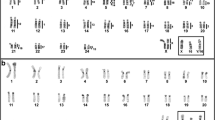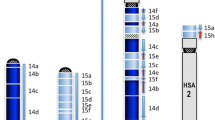Abstract
We hybridized whole human chromosome-specific DNA libraries to chromosomes of two supposed subspecies ofAlouatta seniculus: Alouatta seniculus sara andAlouatta seniculus arctoidea. The number of hybridization signals per haploid set is 42 inA. s. sara and 43 inA. s. arctoidea; the two karyotypes differ by at least 16 chromosomal rearrangements, including numerous translocations. An unusual sex chromosome system is shared by both taxa. The sex chromosome system results from a Y translocation with a chromosome homologous to parts of human chromosome 3/15 and can be described as X1X2Y1Y2/X1X1X2X2 (male/female). Both red howlers also have microchromosomes, a highly unusual karyological trait not found in other higher primates. These microchromosomes are not hybridized by any human chromosome paint and therefore are probably composed of repetitive DNA. It is well known that New World monkeys have high karyological variability. It is probable that molecular cytogenetic analyses including chromosome painting will permit an accurate reconstruction of the phylogeny of these monkeys and help establish the ancestral karyotype for higher primates.
Similar content being viewed by others
References
Armada JLA, Barroso CML, Lima MMC, Muniz JAPC, Seuànez HN (1987). Chromosome studies inAlouatta belzebul.Am J Primatol 13: 283–296.
Arnold N, Seibl R, Kessler C, Wienberg J (1992) Nonradioactive in situ hybridization of digoxigenin labeled DNA probes.Biotech Histochem 67: 59–67.
Bender MA, Chu EHY (1963) The chromosome of primates. In: Buetter-Janusch J. ed.Evolutionary Biology and Genetic Biology of the Primates. New York: Academic Press, pp. 261–310.
Brumback RA, Station RD, Benjamin SA, Lang CM (1971) The chromosomes ofAotus trivergatus Humboldt 1812.Folia Primatol 15: 264–273.
Chu EHY, Bender MA (1961) Chromosome cytology and evolution in primates.Science 133: 1399–1405.
de Boer LEM, Bruijn M (1990) Chromosomal distinction between the red-faced and black-faced spider monkeys (Ateles paniscus paniscus andA. p. chamek).Zoo Biol 9: 307–316.
Dutrillaux B, Webb G, Muleris M, Couturier J, Butler R (1984) Chromosome study ofPresbytis cristatus: presence of a complex Y-autosome rearrangement in the male.Annal de Génét 27: 1–34.
Dutrillaux B, Couturier J, Viegas-Péquignot E (1986) Evolution chromosomique de Platyrhiniens.Mammalia 50: 56–81.
Egozcue J, Egozcue MV (1966) The chromosome complement of the howler monkey (Alouatta caraya Humboldt, 1812).Cytogenetics 5: 20–24.
Galbreath GL (1983) Karyotypic evolution inAotus.Am J Primatol 4: 245–251.
Hershkovitz P (1983) Two new species of night monkeys, genusAotus (Cebidae, Platyrrhini): a preliminary report onAotus taxonomy.Am J Primatol 4: 209–243.
Hill WCO (1960)Primate Comparative Anatomy and Taxonomy IV.Cebidea, part A. Edinburgh: Edinburgh University Press.
Jones TC, Thorington RW, Hu MM, Adams E, Cooper RW (1973) Karyotypes of Squirrel Monkeys (Saimiri sciureus) from different geographic regions.Am J Phys Anthropol 38: 269–278.
King M (1993)Specific Evolution: the Role of Chromosomal Change. Cambridge: Cambridge University Press.
Klever M, Grond-Ginsbach C, Scherthan H, Schroeder-Kurth T, Cremer T (1991) Chromosomal in situ suppression hybridization of human genosomes and autosomes and its use in clinical cytogenetics.Hum Genet 85: 145–150.
Koiffmann CP, Saldhana PH (1974) Cytogenetics of Brazilian monkeys.J Hum Evol 3: 275–282.
Koiffmann CP, Saldhana PH (1981) The karyotype ofCacajao melanocephalus (Platyrrhini, Primates).Folia Primatol 36: 150–155.
Kunkel LM, Heltne PG, Borgaonkar DS (1980) Chromosomal variation and zoogeography in Ateles.Int J Primatol 1: 223–232.
Lima MMC, Seuànez HN (1989) Cytogenetic characterization ofAlouatta belzebul with atypical pelage coloration.Folia Primatol 52: 97–101.
Lima MMC, Seuànez HN (1991) Chromosome studies in the red howler monkey,Alouatta seniculus stramineus (Platyrrhini, Primates): description of an X1X2Y1Y2/X1X1X2X2 sex chromosome system and karyological comparison with other subspecies.Cytogenet Cell Genet 57: 151–156.
Lima MMC, Sampaio MIC, Schneider MPC, Scheffrahn W, Schneider H, Salzano FM (1990) Chromosome and protein variation in red howler monkeys.Brazil J Genet 13: 789–802.
Ma NSF (1981) Chromosome evolution in the owl monkey,Aotus.Am J Phys Anthropol 54: 293–303.
Ma NSF, Jones TC, Thorington RW, Miller A, Morgan L (1975) Y-autosome translocation in the Howler Monkey,Alouatta palliata.J Med Primatol 4: 299–307.
Ma NSF, Elliot MW, Morgan L, Miller A, Jones TC (1976) Translocation of Y chromosome to an autosome in the Bolivian owl monkey,Aotus.Am J Phys Anthropol 45: 191–202.
Ma NSF, Aquino R, Collins WE (1985) Two new karyotypes in the Peruvian owl monkey (Aotus trivieraatus).Am J Primatol 9: 333–341.
Minezawa M, Harada M, Jordan OC, Borda CJV (1985) Cytogenetics of Bolivian endemic red howler monkeys (Alouatta seniculus sara): Accessory chromosome and Y-autosome translocation related numerical variations.Kyoto University Overseas Research Report of New World Monkeys 5: 7–16.
Moore CM, Harris CP, Abee CR (1990) Distribution of chromosomal polymorphism in three subspecies of squirrel monkeys (genusSaimiri).Cytogenet Cell Genet 53: 118–122.
Pinkel D, Straume T, Gray JW (1986) Cytogenetic analysis using quantitative, high-sensitivity, fluorescence hybridization.Proc Natl Acad Sci USA 83: 2934–2938.
Reumer JWF, de Boer LEM (1980) Standardization ofAotus chromosome nomenclature with description of the 2n=49–50 karyotype and that of a new hybrid.J Hum Evol 9: 461–482.
Rumpler Y, Dutrillaux B (1986) Evolution chromosomique des Prosimiens.Mammalia 50: 82–107.
Seuànez HF, Forman L, Matoyoshi T, Fanning TG (1989) TheCallimico goeldii (Primates, Platyrrhini) genome: karyology and middle repetitive (Line-1) DNA sequences.Chromosoma 98: 389–395.
Small MF, Stanyon R, Smith D, Sineo L (1985) High resolution chromosomes of rhesus macaque.Am J Primatol 9: 63–67.
Stanyon R, Arnold N, Koehler U, Bigoni F, Wienberg J (1995) Chromosomal painting shows that marked chromosomes in lesser apes and Old World monkeys are not homologous and evolved by convergence.Cytogenet Cell Genet 68: 74–78.
Stanyon R, Tofanelli S, Morescalchi MA, Agoramoorthy G, Ryder OA, Wienberg J (1995) Cytogenetic analysis shows extensive genomic rearrangements between red howler (Alouatta seniculus, Linnaeus) subspecies.Am J Primatol 35: 171–183.
Wienberg J, Jauch A, Stanyon R, Cremer T (1990) Molecular cytotaxonomy of primates by chromosomalin situ suppression hybridization.Genomics 8: 347–350.
Wolfheim JH (1983)Primates of the World: Distribution, Abundance and Conservation. Seattle: University of Washington Press.
Yunis EJ, Torres de Caballero OM, Ramirez C, Ramirez E (1976) Chromosomal variations in the PrimateAlouatta seniculus seniculus.Folia Primatol 25: 215–224.
Author information
Authors and Affiliations
Additional information
accepted for publication by M. Schmid
Rights and permissions
About this article
Cite this article
Consigliere, S., Stanyon, R., Koehler, U. et al. Chromosome painting defines genomic rearrangements between red howler monkey subspecies. Chromosome Res 4, 264–270 (1996). https://doi.org/10.1007/BF02263675
Received:
Revised:
Accepted:
Issue Date:
DOI: https://doi.org/10.1007/BF02263675




